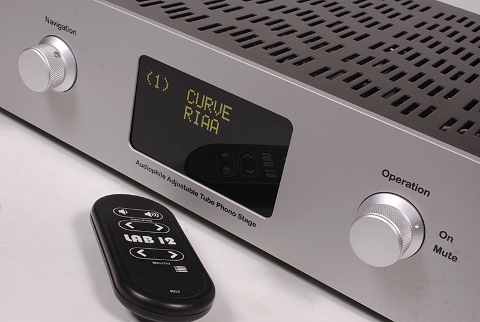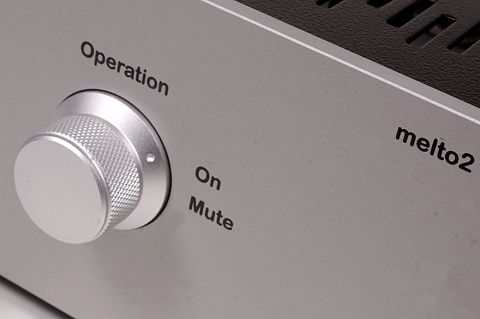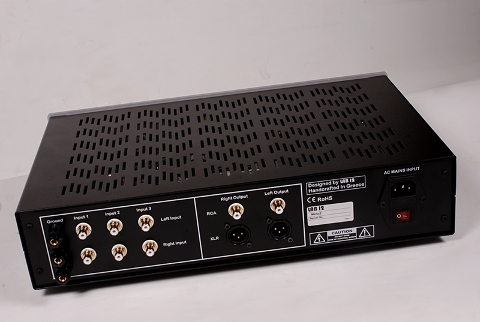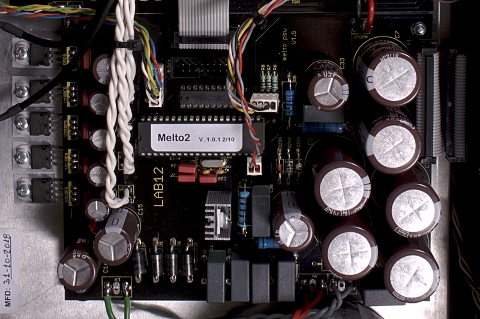about Audio, High Fidelity
& Home Entertainment technologies
pid: 607-2025/10/01 (v1.2)
Privacy Policy

In terms of appearance and aesthetics, melto2 follows the standard LAB12 approach as we know it through their product line in recent years. A classic chassis (430mm wide) with a front panel dominated by a large, monochrome, OLED display, is combined with simple controls (a jog dial to access the menu and a mute switch), to create a low-key but pleasant presence in any equipment rack. The device will be available in two colors, black matte, and silver (Frozen Silver, as shown in the photos).
Connectivity options are very good. The user has at his disposal three inputs for connection of an equal number of cartridge/tonearm combinations, implemented with good quality RCA plugs and corresponding heavy-duty ground terminals. Output to the next stage (presumably a preamplifier or an integrated amplifier) is either via single-ended (RCA), or balanced (XLR) line level connections. Also on the back side of the chassis is the On/Off main switch. This way, LAB12 encourages to leave the preamplifier on, except for long periods of inactivity.
Each one of the three inputs can be individually adjusted for the cartridge generator type, gain, input load and input capacitance, the type of the de-emphasis applied (the choices being between RIAA, Columbia and Decca) as well as for stereo or mono mode. While the gain, load, and capacitance settings are quite important for those looking for the best possible matching of one or more cartridges, the ability to select both the de-emphasis curve and the mono mode, are both, obviously, of special value for heavyweight record collectors, who have on their shelves vinyl pressings outside the stereo LP standard. Given this, we can assume that LAB12's intention is to appeal to the analog community in its widest possible manifestation and not only to hardcore audiophiles.
All options are accessible via the Navigation dial with a clear-cut menu structure, which will not cause any problem even to the one who will use melto2 for the first time. The remote control that comes with the device allows the user to navigate from a distance and, since the highly readable, large-screen display makes this option realistic, the important parameters can be set in real-time from the listening position, a particularly useful feature that leads to a quite straightforward cartridge matching procedure. The switching operation is done in a way that does not cause any perceivable electric noise, as only a quite faint mechanical “click” from the relays is apparent during a selection and only if the music is off.
The monochrome display is particularly easy to read, even at a medium or long distance. The menu structure is quite straightforward and simplifies the setup process.
Inside its chassis, melto2 hides a quite disciplined and high-quality approach. The preamplifier is hand-assembled by LAB12 and features a circuit based exclusively on tubes for the active stages. Each channel includes two double triodes, an Electro-Harmonix 6922 and a Voskhod 6N2P in a four-stage architecture. Each double triode implements two stages, one gain stage, and one cathode follower stage. In the 6922, the cathode follower is used to drive the 6N2P while the 6N2P cathode follower performs as the output stage of the preamplifier. De-emphasis is applied through a passive network, connected between the two tubes and the circuit does not use a global negative feedback loop. To amplify the low-level signal from moving coil phono cartridges, an additional gain stage is used, based on Lundahl's step-up transformers.
Circuit quality is very well looked after, with high precision components and custom MKP capacitors for signal coupling, manufactured to LAB12's specifications. The company states that, in addition to their high precision and quality, the components used in the de-emphasis network are manually selected and matched by measuring their actual values, to ensure minimum tolerances for each preamplifier separately, an approach which justifies some of melto2's performance data (as will be evident in the lab evaluation page). Printed circuit boards feature high-quality copper (35 microns) traces and the design process ensures that these traces maintain a similar geometry and have the same length between the channels for the best possible channel balance and to avoid interference.
The mute switch makes it easier to handle the record playback ritual. User is not required to turn the volume level down between changes.
Melto2 offers three inputs, each of which can be customized through a wide range of settings. The output is available in single-ended and balanced mode. The preamplifier is powered through a switch on the rear panel.
The power supply seems quite robust, featuring a custom toroidal transformer (manufactured to LAB12's specs to maximize induced noise immunity) and a 10H choke, two cascading voltage regulation stages and a total capacity of more than 900μF (with Nippon capacitors) for the anode voltage. The filament heaters are dc powered through voltage regulators, one for each tube, while local regulation is also used for the other voltages required (for the screen, the microcontroller, and the switching circuits).
Melto2 relies on an Atmel micro for its control-related functions, with software developed by LAB12. In practice, selections made by the user, through the available menu, are conveyed as commands to a large number of both reed and standard electromagnetic relays (from Coto and Omron respectively) with the former controlling the current input parameters and the later the equalization curves and the input selection.
Inside the chassis of melto2, on the left, are the power transformer and the power supply chock, while the rest of the power supply is located towards the middle. The rest of the free space is occupied by the preamplifier circuit.
The main power supply feeds local regulators (including these for the heating filaments). An Atmel microcontroller has been assigned to the control of the whole device (center).
The melto2 circuit is based on two double triodes per channel and a pair of Lundahl transformers for MC pre-amplification. The photo also shows the load and capacitance setting relays (left) and the de-emphasis network relays (center). The circuit features custom coupling capacitors labeled with LAB12's logo.
Previous | Next | More Reviews









